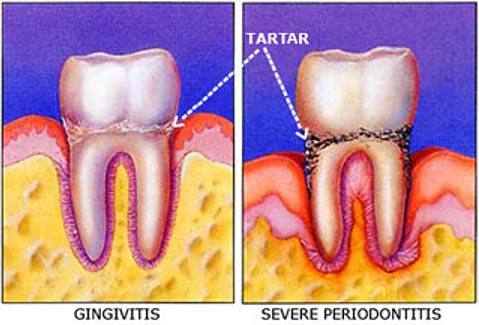


In the last few years, researchers have found that people with gum disease are almost twice as likely to suffer from coronary artery disease. More research is coming, linking other diseases as well. Gum disease (to dentists -periodontal disease) can be prevented, but if the diagnosis has been made and treatment is required, we work with you to achieve the best gum health possible.

Germs (bacteria) are the main culprits in the cause of gum disease. They live in soft plaque and in the space between the gum and the tooth (pocket). If left alone, plaque calcifies into the tartar shown at the left in the photo above. The gums become raw and sores open up, causing an invasion of bacteria around the tooth (gingivitis). This low grade infection progresses over time, until the bone starts being involved. Once the bone is involved, the disease has progressed from gingivitis to periodontitis. Beyond this the bone can dissolve down the roots of the tooth, causing the tooth to eventually loosen. This is severe periodontitis.
With periodontitis, it is often necessary to return for deep cleaning (scaling and root planing) to thoroughly remove the tartar, usually with numbing agents, in 2-4 visits. An assessment of the gums (measuring or "probing") is done to compare the health of the gums at future visits. Detailed instructions are given on how to care for your gums and teeth to help stop the progression of the disease. In our office, we utilize low level laser therapy to reduce bacteria levels in the pockets as well. Some of our patients are referred to a specialist, a Periodontist, for gum surgery or further treatment. Once the disease is under control, you'll return for frequent "periodontal maintenance" cleanings- usually every 3-4 months, or alternating with the Periodontist in some cases.
Though dental technology has come a long way in saving teeth, the time comes when a tooth needs extraction. We do some extractions right in house. In other cases, we may refer our patients to a specialist (an Oral Surgeon). We work closely with many Oral Surgeons in the area.
Benefits of losing or keeping the tooth are covered before any action is mutually decided upon. Advances in dentistry have allowed for many tooth replacement options. We will work with you to plan the best treatment, if any, following your extraction. We cover the physical, emotional, and financial issues involved in each case.

Once a tooth is extracted, a dental implant can be used to replace it. An implant is a false tooth root. Dentists have been placing implants since the 1960's. It has only been since about 1990 that they have become predictable in process, healing and function.
Implant dentists have their preferences, and so do ours. At MVD, we do not place implants in the bone. We team up with trusted specialists - oral surgeons - who do this work frequently as part of their routine. We DO place the crowns, bridges and dentures that attach to these prosthetic roots.
After placing an implant, time is given for the bone to heal and stabilize, then the "replacement tooth" (crown, bridge, denture) can be placed on the implant(s). Cases and circumstances vary widely for each patient, so please contact us to schedule a consultation for more information.
